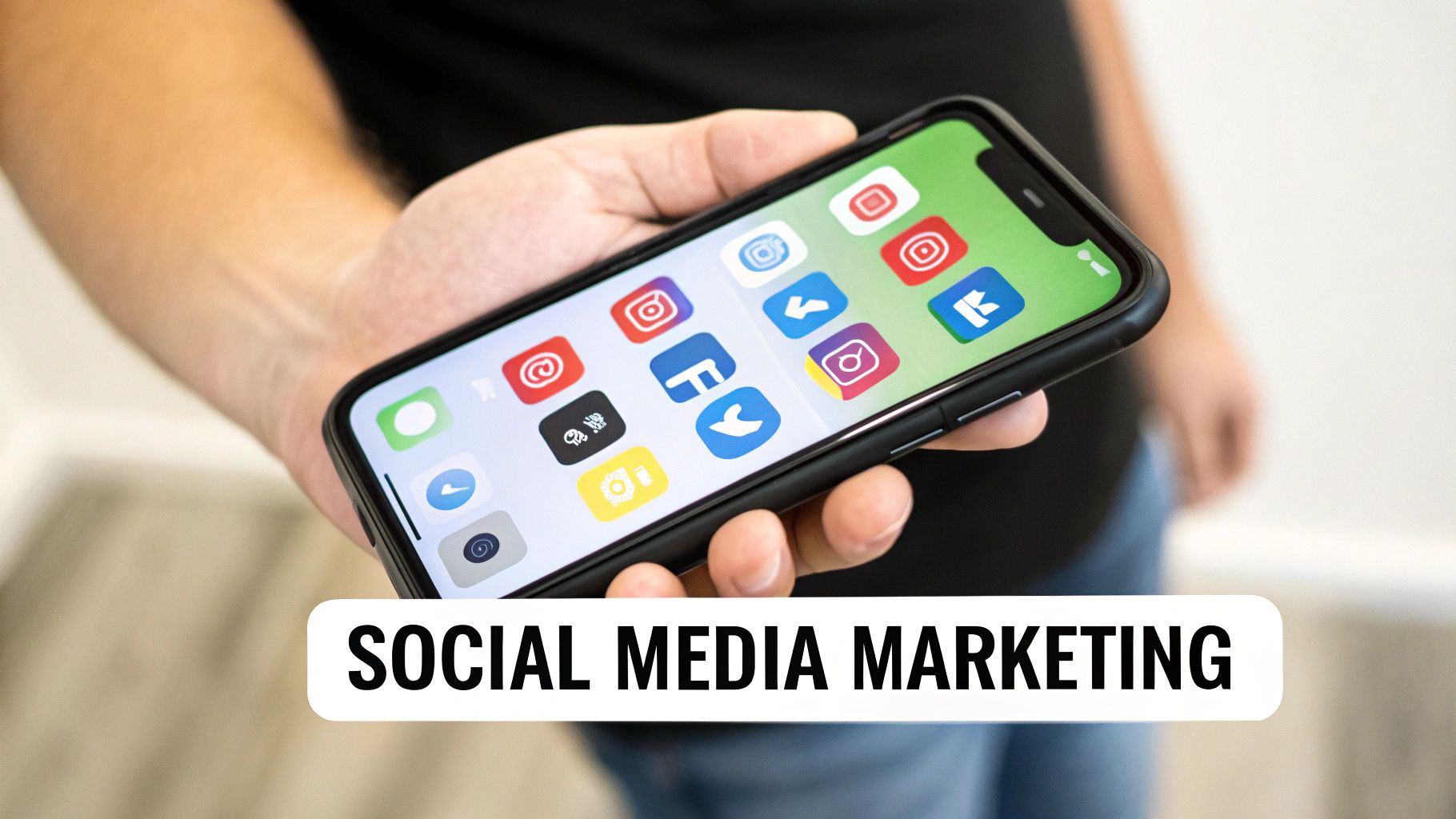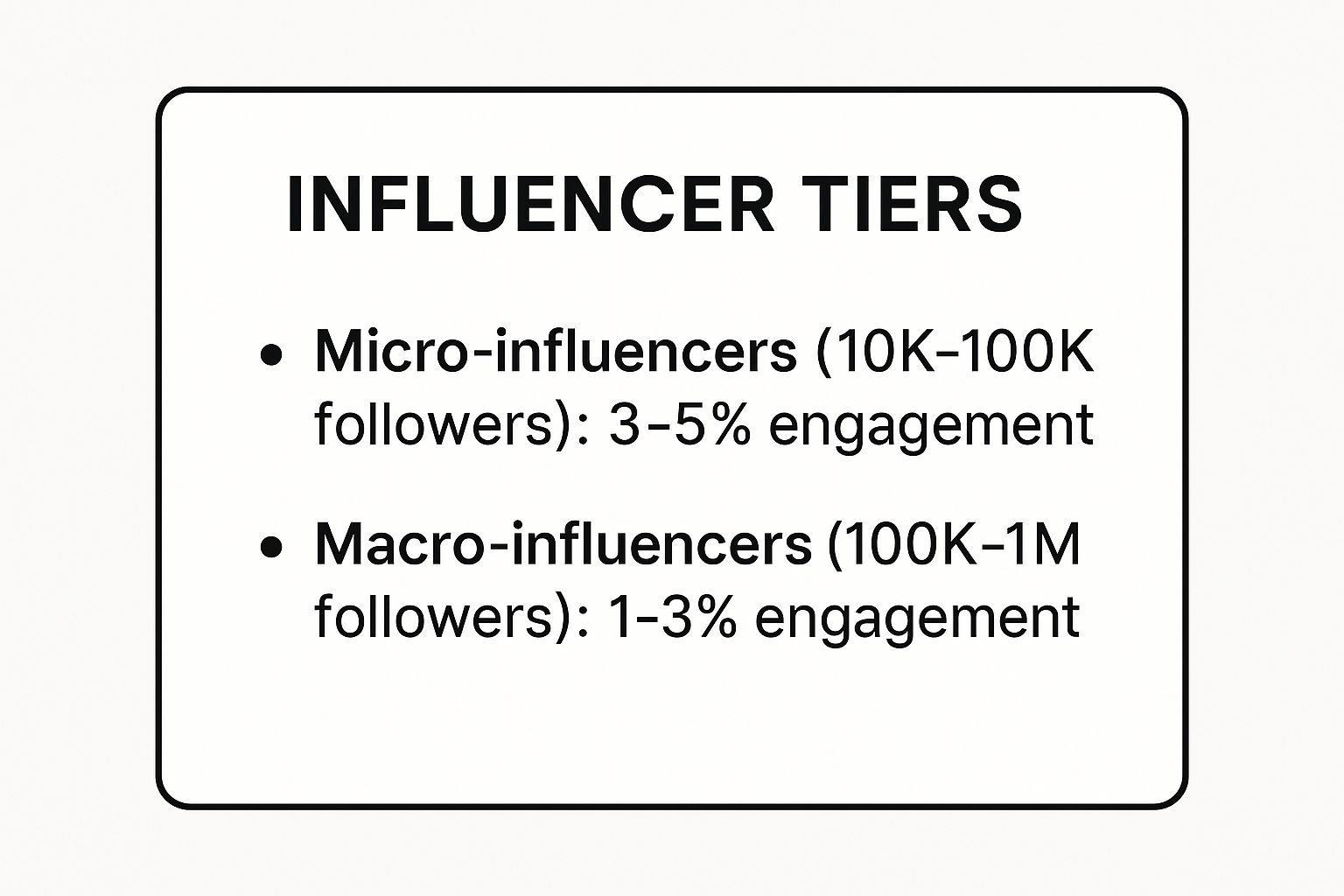Launching a new business is an incredible achievement, but the real work begins when you need to attract your first customers. With limited budgets and brand recognition, choosing the right approach can feel overwhelming. This guide cuts through the noise to deliver a curated collection of proven, actionable marketing strategies for new businesses. We'll move beyond generic advice and provide you with a clear roadmap to build momentum from day one. Instead of just telling you what to do, we'll show you how to implement each strategy with practical steps and real-world examples.
The goal isn't just to market your business; it's to build a sustainable engine for growth. Each strategy detailed here is a powerful tool designed to help you connect with your target audience, establish credibility, and drive meaningful results. Before diving into these specific tactics, it's crucial to have a foundational framework. For a step-by-step guide on structuring your overall approach, start by creating a solid marketing plan. This initial step will ensure every action you take aligns with your long-term business objectives. From there, this list will provide the specific plays to execute your vision and turn your launch into a lasting success story.
1. Content Marketing
Content marketing is one of the most powerful and cost-effective marketing strategies for new businesses. Instead of directly selling your products or services, you create and share valuable, relevant content to attract and engage your target audience. This approach positions your startup as a helpful expert, building trust and credibility long before a customer is ready to buy.

By consistently providing answers to your audience's biggest questions, you attract qualified leads and nurture them into loyal customers. For example, a fintech startup could create a blog with financial advice, just as Mint did to drive its initial growth. Similarly, HubSpot became a marketing giant by offering comprehensive guides and resources, attracting businesses that eventually became customers.
How to Implement Content Marketing
A strong content strategy is a core component of your overall brand identity. Learn more about how to develop your brand with our guide to brand strategy for startups.
- Start Small and Focused: Don't try to be everywhere at once. Master one content type first, like a blog or a YouTube channel, before expanding.
- Solve, Don't Sell: Focus every piece of content on solving a specific problem for your ideal customer. Use the "They Ask, You Answer" methodology to guide your topics.
- Repurpose Your Winners: Turn a successful blog post into a video, an infographic, and a series of social media updates. This maximizes your effort and reaches different audience segments.
- Track Your Performance: Use analytics to see what content resonates. Track metrics like page views, time on page, and conversion rates to refine your strategy.
2. Social Media Marketing
Social media marketing is an essential strategy for new businesses looking to connect directly with their audience, build brand awareness, and drive sales. It involves using platforms like Instagram, TikTok, LinkedIn, and Facebook to share content, engage with followers, and run targeted advertising campaigns. This approach provides unparalleled access to customers, allowing you to build a community around your brand from day one.

This method allows startups to compete with established players by creating authentic connections and viral moments. For instance, Dollar Shave Club’s hilarious launch video went viral on YouTube, catapulting the brand to fame. Similarly, Gymshark built its empire by partnering with fitness influencers, while Wendy's witty Twitter presence created a distinct and memorable brand personality. These examples show how a smart social media presence can be a game-changer.
How to Implement Social Media Marketing
Effective social media starts with a deep understanding of who you're trying to reach. To get started, you can learn how to find your target audience with our 5-step guide.
- Choose Platforms Wisely: Don't spread yourself thin. Focus on the 2-3 platforms where your target audience is most active and engaged.
- Post with a Plan: Consistency is key. Develop a content calendar to plan your posts in advance, ensuring a steady stream of valuable and relevant content.
- Engage Authentically: Social media is a two-way street. Respond to comments and messages promptly, participate in conversations, and show the human side of your brand.
- Leverage Platform-Specific Features: Master features like Instagram Reels, TikTok videos, or LinkedIn articles to maximize your reach and engagement on each platform.
3. Search Engine Optimization (SEO)
Search Engine Optimization (SEO) is the practice of optimizing your website to rank higher in search engine results like Google. For new businesses, SEO provides sustainable, long-term visibility that drives qualified traffic without ongoing advertising costs. It is a fundamental part of any digital marketing strategy, ensuring customers can find you when they are actively searching for solutions you provide.
This strategy builds an asset that grows in value over time. By appearing on the first page of search results, you establish authority and trust. For example, Warby Parker targeted local eyewear searches to drive foot traffic to its new stores, while Zappos optimized every product page to capture shoppers looking for specific shoe models. These are prime examples of how SEO can be a core driver of business growth from day one.
How to Implement SEO
Effective SEO is a core part of building a digital presence. It is one of the most vital marketing strategies for new businesses looking to establish a foothold online.
- Start with Local SEO: If you have a physical presence or serve a specific geographic area, claim your Google Business Profile. Optimize it with your business information and encourage customer reviews to appear in local "near me" searches.
- Focus on Long-Tail Keywords: Instead of targeting highly competitive terms like "shoes," aim for more specific phrases like "comfortable running shoes for women with flat feet." These have lower competition and attract highly motivated buyers.
- Prioritize Page Speed and Mobile Experience: Google prioritizes websites that load quickly and work well on mobile devices. Ensure your site is responsive and optimized for speed to provide a great user experience and improve rankings.
- Build Relationships for Backlinks: Don't just ask for links. Build genuine relationships with other businesses, bloggers, and publications in your industry. High-quality backlinks from reputable sites are a powerful signal to search engines that your content is trustworthy.
4. Email Marketing
Email marketing remains one of the most effective marketing strategies for new businesses, offering a direct line of communication to your audience. It consistently delivers the highest return on investment among digital channels because it allows you to build a relationship with prospects and customers in their own space: their inbox. Unlike social media, you own your email list, making it a stable and reliable asset for growth.

This strategy is about more than just sending promotions; it's about nurturing leads with personalized, valuable content. For example, Grammarly sends weekly writing improvement emails that provide genuine value, reinforcing its brand authority. Similarly, TheSkimm built a media empire by delivering a must-read daily newsletter, proving that consistent, high-quality email content can create a loyal community and a powerful business.
How to Implement Email Marketing
Building an engaged email list is a foundational step in creating a sustainable sales funnel. It allows for direct, targeted communication that can convert subscribers into lifelong customers.
- Offer a Valuable Lead Magnet: Build your list by offering something irresistible in exchange for an email address, like a free guide, checklist, or webinar.
- Segment Your Audience: Don't send the same message to everyone. Group your subscribers based on their interests, behaviors, or where they signed up to send more relevant, personalized content.
- Focus on Value First: Your emails should primarily help, educate, or entertain. Aim for a ratio of 80% value to 20% sales-focused content to keep subscribers engaged and happy to hear from you.
- Optimize for Mobile: A significant portion of emails are opened on mobile devices. Ensure your design is responsive and easy to read on a small screen.
5. Referral Marketing
Referral marketing transforms your happiest customers into a powerful, voluntary sales force. This strategy incentivizes existing users to recommend your products or services to their network, leveraging trusted word-of-mouth to drive growth. For new businesses, this is one of the most effective marketing strategies because it generates high-quality leads with significantly lower acquisition costs and higher lifetime value.
A referred customer is more likely to trust your brand because the recommendation comes from someone they know. The classic example is Dropbox, which offered extra storage space to both the referrer and the new user, fueling its explosive early growth. Similarly, Airbnb's dual-sided incentive program, giving travel credits to both parties, helped it scale into a global hospitality leader by building a community of advocates.
How to Implement Referral Marketing
A well-executed referral program can be a cornerstone of your growth engine and a fantastic way to boost brand visibility. Discover more in our guide on how to improve brand awareness with top strategies to boost visibility.
- Make It Effortless: The referral process must be incredibly simple. A customer should be able to share their unique link or code in just one or two clicks.
- Offer Dual-Sided Incentives: Reward both the referrer and the new customer. This creates a win-win scenario that motivates both sides to participate.
- Time Your Request Perfectly: Ask for a referral immediately after a customer has a positive experience, such as after a successful purchase, a 5-star review, or a resolved support ticket.
- Promote Your Program: Don't just build it and hope they come. Actively promote your referral program in emails, on your website, within your app, and on social media.
6. Partnership Marketing
Partnership marketing is a powerful strategy where you collaborate with another business to promote each other. Instead of building an audience from scratch, you tap into a partner's established customer base, instantly gaining credibility and reach. This approach is one of the most effective marketing strategies for new businesses because it accelerates growth by leveraging shared resources and trust.
This strategy allows you to access new, relevant audiences at a fraction of the cost of traditional advertising. For example, the iconic partnership between GoPro and Red Bull combined a high-octane brand with a camera company, creating mutually beneficial content that reached millions. Similarly, Spotify and Uber partnered to allow riders to control the music during their trip, enhancing the customer experience for both brands.
How to Implement Partnership Marketing
Finding the right partner is the most critical step. Your success depends on aligning with a business that complements your own, creating a win-win scenario for both you and your shared audience.
- Choose Partners with Complementary Audiences: Look for non-competing businesses that serve the same ideal customer profile. If you sell high-end coffee beans, a partnership with a local artisanal bakery makes perfect sense.
- Ensure Brand Values Align: A mismatch in values can damage your reputation. Partner with businesses that share your commitment to quality, customer service, and overall brand ethos.
- Start with Small, Testable Collaborations: Before committing to a large-scale campaign, test the waters with a smaller joint venture, like a co-hosted webinar or a shared social media giveaway.
- Define Clear Roles and Expectations: Create a formal agreement that outlines responsibilities, timelines, goals, and how you will measure success to prevent misunderstandings.
7. Local Marketing
For new businesses with a physical storefront or a defined service area, local marketing is not just a strategy; it's essential for survival. This approach focuses all marketing efforts on attracting customers within a specific geographic area, from your neighborhood to your entire city. It builds community presence, leverages location-based search, and creates strong local brand recognition through targeted, geographically relevant campaigns.
Instead of competing on a national or global scale, you become the go-to provider in your community. For example, a new coffee shop can host community events to draw in locals, a small gym might sponsor a local sports team for visibility, and a plumbing service can dominate "near me" searches. This direct engagement fosters a loyal customer base that bigger, non-local competitors can't replicate. It's one of the most direct and impactful marketing strategies for new businesses that serve a local audience.
How to Implement Local Marketing
A powerful local marketing plan puts your business on the map, literally and figuratively. It ensures that when local customers need what you offer, your name is the first one they think of and find.
- Claim and Optimize Google My Business: This is your digital storefront. Fill out every section, add high-quality photos, encourage customer reviews, and use the Q&A feature to answer common questions.
- Encourage Local Reviews: Actively ask satisfied customers to leave reviews on platforms like Google, Yelp, and Facebook. Positive reviews are a massive trust signal for local search algorithms and potential customers.
- Get Involved in the Community: Participate in or sponsor local events, fairs, and sports teams. This puts your brand directly in front of your target audience and shows you are invested in the community.
- Partner with Other Local Businesses: Team up with non-competing local businesses for cross-promotions. A new bakery could partner with a nearby coffee shop to offer a discount package, benefiting both establishments.
8. Guerrilla Marketing
Guerrilla marketing leverages unconventional, high-impact tactics to generate maximum exposure on a minimal budget. Instead of traditional advertising, this strategy relies on creativity, surprise, and innovation to create memorable experiences that get people talking. For new businesses, guerrilla marketing is one of the most effective strategies to cut through the noise and generate buzz without a large financial investment.
This approach is about creating a spectacle or a unique interaction that captures public attention. For example, Red Bull’s extreme sports stunts, like the famous Stratos space jump, are textbook guerrilla marketing, associating the brand with energy and daring. Similarly, a flash mob proposal organized by an engagement ring company creates a viral moment that is both emotionally resonant and highly shareable.
How to Implement Guerrilla Marketing
Effective guerrilla campaigns are more about imagination than budget, making them a powerful tool for startups. They are a core part of many disruptive marketing strategies for new businesses looking to make a name for themselves.
- Align with Your Brand: Ensure your stunt or campaign is a genuine reflection of your brand's personality and values. An edgy campaign won't work for a conservative financial services firm.
- Plan for Amplification: The real power of guerrilla marketing lies in its digital afterlife. Document everything with high-quality photos and videos to share across social media.
- Check Legal and Safety: Ambush marketing or public stunts can have legal and safety implications. Always check local regulations and ensure your event is safe for everyone involved.
- Be Ready for Anything: Unconventional tactics can have unpredictable outcomes. Have a crisis management plan in place in case the public reception isn't what you expected.
9. Influencer Marketing
Influencer marketing is a powerful strategy that involves partnering with individuals who have established credibility and a dedicated following in a specific niche. For new businesses, this approach provides a shortcut to trust and reach. Instead of building an audience from scratch, you tap into an existing community that already trusts the influencer's recommendations, making it a highly effective marketing strategy for new businesses.
This form of social proof is incredibly authentic. When an influencer genuinely loves a product, their endorsement feels less like an advertisement and more like a trusted friend's advice. For example, watch brand Daniel Wellington grew exponentially by gifting watches to micro-influencers, who then shared photos with their engaged followers. Similarly, Gymshark built its empire by creating a community of fitness influencers who became genuine brand ambassadors.
How to Implement Influencer Marketing
To get started, you don't need a massive budget; you need a smart approach focused on authenticity and relevance. Focus on finding partners whose audience perfectly matches your ideal customer profile.
- Start with Micro-Influencers: Don't chase huge follower counts. Micro-influencers (typically 10k-100k followers) often have higher engagement rates and a more dedicated, niche audience, delivering better ROI.
- Prioritize Engagement Over Followers: A high follower count is meaningless if the audience isn't engaged. Analyze an influencer's like-to-comment ratio and the quality of their audience interactions before partnering.
- Grant Creative Freedom: Provide clear guidelines and campaign goals, but allow the influencer creative control. Their audience follows them for their unique voice, and forcing overly scripted content will feel inauthentic.
- Build Long-Term Relationships: Aim for long-term partnerships instead of one-off posts. A sustained collaboration builds deeper trust with the audience and reinforces your brand's presence over time.
10. Influencer Marketing
Influencer marketing involves collaborating with individuals who have a dedicated social media following to promote your product or service. This strategy leverages the trust and credibility influencers have built with their audience, allowing your brand to reach a highly engaged and relevant customer base. For new businesses, it's a powerful way to generate authentic buzz and social proof quickly.
This approach is one of the most effective marketing strategies for new businesses looking to bypass traditional advertising noise. For example, a new fashion brand could partner with style bloggers for a "get the look" post, or a meal kit startup could sponsor a popular food vlogger's recipe video. These collaborations feel more like trusted recommendations than overt ads, driving higher engagement.
This infographic summarizes the typical engagement rates for different influencer tiers.

The data shows that smaller, micro-influencers often deliver a higher engagement rate, making them a cost-effective choice for startups with limited budgets.
How to Implement Influencer Marketing
A successful influencer campaign requires careful planning and genuine relationship-building. It is not just about paying for a post; it is about finding the right partner to represent your brand.
- Focus on Micro-Influencers: Start with influencers who have smaller but more dedicated followings (typically 10k-100k). They often have higher engagement rates and are more affordable for new businesses.
- Prioritize Authenticity: Look for influencers whose values and aesthetic align perfectly with your brand. Their endorsement must feel natural to their audience.
- Co-Create Content: Work with the influencer to create content that feels authentic to their style while clearly communicating your brand's message. Give them creative freedom.
- Track Key Metrics: Measure success by tracking metrics like reach, engagement rate, website clicks, and conversions using unique discount codes or UTM-tagged links.
Marketing Strategies Comparison Matrix
Your Next Move: Turning Strategy into Action
Embarking on the marketing journey for your new business can feel like navigating a vast, uncharted territory. The strategies we've explored, from the foundational power of content marketing and SEO to the creative spark of guerrilla and influencer campaigns, are not just isolated tactics; they are interconnected tools in your arsenal. The key isn't to implement every single one tomorrow but to understand that the most successful marketing strategies for new businesses are built on a cohesive, integrated approach.
Think of it as building a puzzle. Your content is a core piece, your social media presence connects to it, and your email marketing nurtures the leads generated by both. SEO ensures the entire puzzle is visible to those searching for it, while referral and partnership marketing expand its reach exponentially. Each strategy reinforces the others, creating a powerful engine for sustainable growth. The goal is to move from simply doing marketing to building a strategic marketing ecosystem where each component adds value to the whole.
Your Immediate Action Plan
Feeling overwhelmed is natural, but momentum is your greatest asset. Don't get stuck in analysis paralysis. Instead, focus on taking small, decisive steps forward. Here’s how you can start turning these ideas into tangible results today:
- Choose Your "One Thing": Review the list. Which single strategy resonates most with your business model and target audience? Is it building a hyper-local community, or could a strategic partnership give you immediate credibility? Pick one and commit to launching a small-scale test within the next 14 days.
- Set a Micro-Goal: Don't aim to "master content marketing." Instead, set a goal to "publish two high-value blog posts" or "secure one guest post on an industry blog." For social media, it could be "gain 100 relevant followers on LinkedIn." Small, measurable wins build confidence and provide valuable data.
- Audit Your Foundation: Before you build, check your foundation. Is your website optimized for conversions? Is your brand messaging clear and consistent? A quick audit ensures that the traffic you generate from your new marketing efforts has a place to land and a reason to stay.
The power of these marketing strategies for new businesses lies in their consistent and thoughtful application. It’s about more than just attracting eyeballs; it's about building genuine relationships, establishing trust, and creating a brand that customers not only choose but champion. By starting small, measuring your results, and adapting your approach, you transform abstract strategies into a predictable engine for customer acquisition and long-term success. Your journey to market leadership begins not with a giant leap, but with the first intentional step you take today.
Ready to build the strong digital foundation your marketing strategies need? Softriver specializes in crafting professional websites and compelling brand identities that make new businesses look established from day one. Let us handle the technical and design heavy-lifting so you can focus on executing your growth plan. Visit Softriver to see how we can accelerate your launch.







